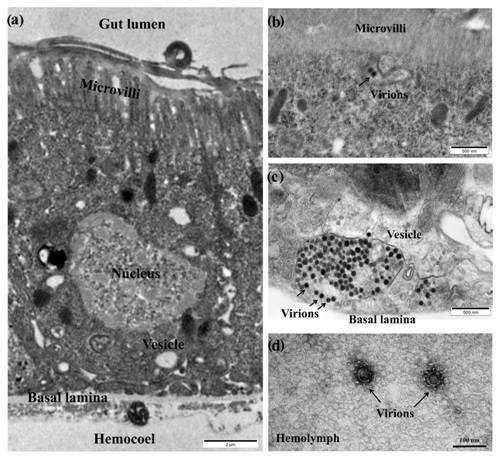Southern rice black-streaked dwarf virus hijacks SNARE complex of its insect vector for its effective transmission to rice
Lu Zhang, Wenwen Liu, Xiaowan Zhang, Li Li, Xifeng Wang

南方水稻黑条矮缩病毒在介体白背飞虱中肠和血淋巴中的分布 中国农科院植保所供图

南方水稻黑条矮缩病毒利用白背飞虱囊泡运输突破中肠屏障示意图 中国农科院植保所供图
8月15日,《分子植物病理学》(Molecular Plant Pathology)在线发表了中国农业科学院植物保护研究所作物病毒病害流行与控制创新团队的研究论文。该研究发现了南方水稻黑条矮缩病毒(SRBSDV)通过病毒外壳蛋白P10与介体白背飞虱SNARE家族的膜融合相关蛋白(VAMP7、Vti1a)互作,而进入到中肠上皮细胞的囊泡,并融合形 成一个大的囊泡,最终突破中肠细胞释放大量病毒粒子,以实现病毒高效传播的过程。
自然界中近70%的植物病毒传播需要依靠介体昆虫。介体昆虫在取食植物韧皮部汁液时,植物病毒尤其是持久型病毒会随着汁液被摄入到昆虫的肠道中,通过跨越上皮细胞进入血淋巴,借助昆虫的循环系统到达唾液腺。再次取食时,病毒会随着唾液进入到健康植物体。介体昆虫的高效传毒是导致病害暴发流行的关键,而突破中肠是病毒进入到昆虫体内第一个也是最为重要的屏障。
研究发现,介体昆虫中肠上皮细胞中存在大量包裹着病毒粒子的囊泡,以病毒的外壳蛋白P10为诱饵通过酵母双杂交筛选获得了两种囊泡相关膜蛋白VAMP7和Vti1a,含有Vti1a/VAMP7的SNARE复合体主要参与细胞的物质运输。
介体昆虫获毒后,病毒与VAMP7或Vti1a在中肠上皮细胞中随着时间的延长共定位逐渐增多,并由细胞质转移到细胞膜上。干扰VAMP7或Vti1a表达并不影响病毒进入肠道及在肠道中的积累,但显著降低了病毒在血淋巴的积累量,同时显著抑制了传毒率。这说明病毒通过与VAMP7和Vti1a互作利用介体囊泡运输系统进行自身的运输和扩散。
该研究揭示了植物呼肠孤病毒劫持囊泡以克服媒介昆虫中肠逃逸障碍的关键机制,为囊泡运输在病毒传播中的作用提供了新的见解,同时为阻断病毒病的传播提供靶标。
中国农科院植保所博士研究生张璐为论文的第一作者,副研究员刘文文为通讯作者,研究员王锡锋参与了相关工作和指导。
该研究得到国家自然科学基金和国家重点研发计划的资助。
来源:中国科学报 李晨
Abstract
Vesicular trafficking is an important dynamic process that facilitates intracellular transport of biological macromolecules and their release into the extracellular environment. However, little is known about whether or how plant viruses utilize intracellular vesicles to their advantage. Here, we report that southern rice black-streaked dwarf virus (SRBSDV) enters intracellular vesicles in epithelial cells of its insect vector by engaging VAMP7 and Vti1a proteins in the soluble N-ethylmaleimide-sensitive factor attachment protein receptor (SNARE) complex. The major outer capsid protein P10 of SRBSDV was shown to interact with VAMP7 and Vti1a of the white-backed planthopper and promote the fusion of vesicles into a large vesicle, which finally fused with the plasma membrane to release virions from midgut epithelial cells. Downregulation of the expression of either VAMP7 or Vti1a did not affect viral entry and accumulation in the gut, but significantly reduced viral accumulation in the haemolymph. It also did not affect virus acquisition, but significantly reduced the virus transmission efficiency to rice. Our data reveal a critical mechanism by which a plant reovirus hijacks the vesicle transport system to overcome the midgut escape barrier in vector insects and provide new insights into the role of the SNARE complex in viral transmission and the potential for developing novel strategies of viral disease control.



